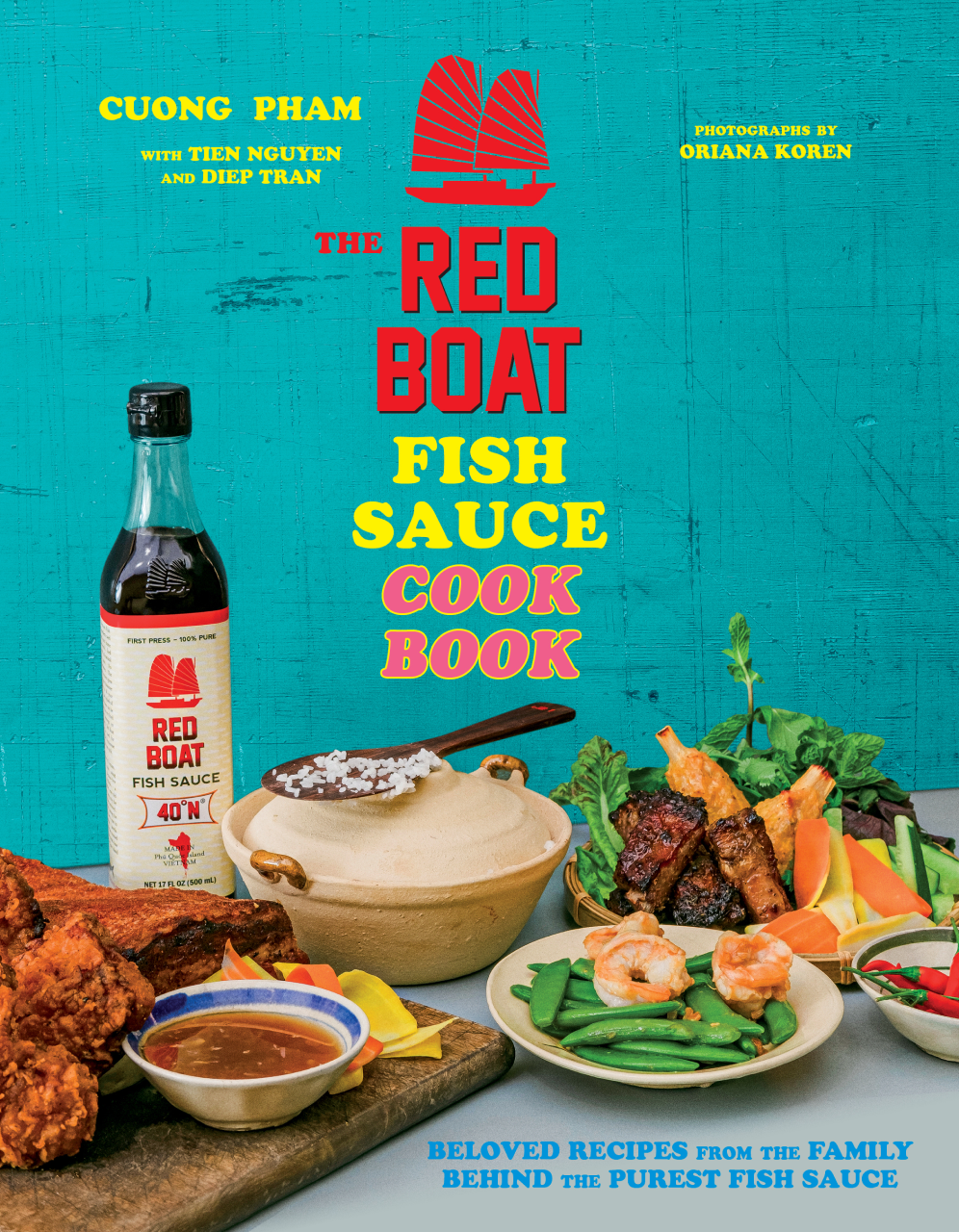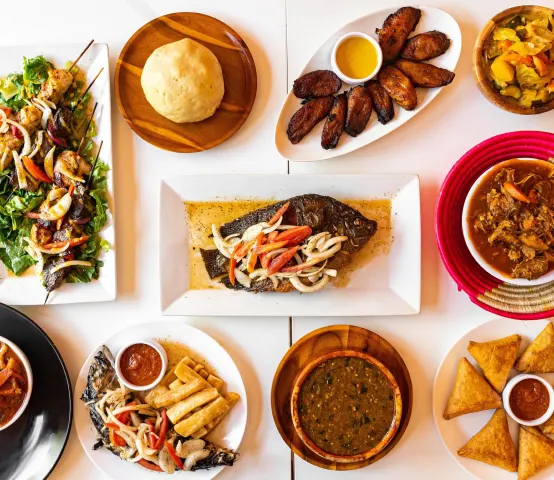
Cuong Pham launched Red Boat in 2011 in Northern California, but the origins of Red Boat go back to the end of what the Vietnamese call the American War, the 20 years of conflict following our intervention to prop up a failing French colonial state. In the late ‘70s Pham’s mother put her teen-aged son on a boat with the hope he’d join his siblings starting a new life. Nine months later he was in the Bay Area, and within a few years Pham was working for Apple.

It took a decade to bring his mother to the US, and she began once again to cook the foods Pham and his siblings grew up with. But they always felt there was something missing. “That’s when we finally figured it out!” explains Pham. “The fish sauce here just wasn’t the same as the fish sauce there.”
Another decade passed before Pham, by now a world-traveling tech consultant discovered the lost ingredient. While visiting Saigon, he went to Phú Quốc, an island known for its fish sauce production, and sampled some straight from the fermenting barrels. The flavor took him back to his childhood, and when he brought a bottle back to California for his mother, she cried.
Pham eventually invested in a fish sauce barrel house on the island in exchange for a direct supply, but within a few months the original owners left the business. It took Pham a few years to dial in the process of fermenting the area’s black anchovies to get the pure flavor he wanted by salting the fish on the boat as soon as they were caught. His fish sauce cost more to make, but Pham relied on what he learned from Steve Jobs at Apple, to make the very best product he could. He believed that once cooks tasted his fish sauce and discovered its unique depth of flavor, they’d come back for more. And they did.



While Red Boat fish sauce might not be in every kitchen, it should be, and the new Red Boat Fish Sauce Cookbook shows why. Cuong Pham collected a hundred recipes to show how cooks can make almost everything taste better, from Vietnamese classics like phở and bánh mì to such American standards as tomato sauce and Thanksgiving turkey.
Photo credit goes to @redboatfishsauce @asia.street.food@suburbandirtgirl
Mom’s Gà Quay (Roast Chicken)
Adapted from The Red Boat Fish Sauce Cookbook by Cuong Pham
Serves 4


This recipe is an adaptation of my mother’s recipe for gà quay, which loosely translates to “rotisserie” or “roasted chicken.” As with many home cooks in Vietnam at the time, she didn’t have access to an oven, so she steamed the chicken instead, then doused it in sizzling hot oil to brown and crisp the skin. The result was similar to what she would have made had it been cooked in the oven. Given that ovens are very much part of American kitchens, we modified her technique slightly. We use the same flavorings she used—fish sauce, soy sauce, bay leaves—to marinate the bird, but we forego her oil method in favor of butterflying and roasting the chicken instead.
A note about equipment: We specify using an 8-x-10-inch wire rack fitted in a 9-x-13-inch baking sheet. If you use a larger baking sheet, the delicious juices that render during the roast will burn.
Basting Liquid
2 tablespoons diced garlic
½ cup diced shallots
¼ cup apple cider vinegar
¼ cup Red Boat Fish Sauce
¼ cup of soy sauce
¼ teaspoon ground black pepper
2 bay leaves
2 tablespoons granulated sugar
¼ pound butter, cubed
Seasoning Paste
1 cup roughly chopped white or yellow onions
5 cloves garlic, roughly chopped
2 teaspoons Red Boat Fish Sauce
2 tablespoons extra virgin olive oil
1 teaspoon ground black pepper
1 (2- to 3-pound) whole chicken
For Serving
Nước Chấm Gừng (Ginger Dipping Sauce)
makes about ½ cup
¼ cup plus 2 tablespoons granulated sugar
3 tablespoons sliced ginger
1 ½ tablespoons smashed garlic
1 teaspoon chopped Thai chile
¼ cup Red Boat fish sauce
1 tablespoon lime juice
1. Add the sugar, sliced ginger, garlic, and chiles to a mortar. Use a pestle to break down the spices and release the oils into the sugar. Once the ginger and garlic are completely broken down, remove the pestle. Stir the mixture for 5 minutes, until the sugar granules melt.
2. Add fish sauce, lime juice, and ½ cup of water. Stir to combine. It’s ready to use right away. Transfer any remaining nước chấm to an airtight container and cover. It will keep for about 1 week.
Make the basting liquid.
1. In a small saucepan, combine the garlic, shallots, vinegar, and ¼ cup of water. Bring the mixture to a boil and cook until the vinegar and water are almost all evaporated, about 5 minutes.
2. Add the fish sauce, soy sauce, black pepper, and bay leaves to the pan. Turn down the heat to low and keep the mixture at a low simmer for 15 minutes.
3. Transfer the mixture to a mixing bowl. Add the sugar and a few cubes of butter to the bowl, and stir gently to melt the butter. Repeat with the remaining butter.
4. Strain and discard the solids to make a velvety sauce. Cover the sauce and store in the refrigerator until needed.
Butterfly and marinate the chicken.
5. In a blender, combine all the ingredients for the seasoning paste and process them. Set aside.
6. Remove the excess fat from around the thighs and neck of the chicken. Position the chicken so the legs face you. Using sharp kitchen shears, cut along either side of the backbone and remove it, then put both your palms on the chicken and press down; you should hear a crack as the chicken flattens.
7. Apply half of the seasoning paste underneath the skin of the chicken by tucking your hand between the skin and flesh. Repeat for the breast and thigh areas, then rub the remaining paste all over the exterior of the chicken.
8. Place the chicken breast-side up onto a dish lined with a wire rack and place it, uncovered, in the refrigerator. Let the chicken marinate for at least 8 hours, or up to 2 days.
Roast the chicken.
9. When you’re ready to roast, preheat the oven to 375°F. Remove the chicken and the basting liquid from the refrigerator. Using a basting brush, apply a generous coat of the basting liquid onto the skin of the chicken, including the backside, until the skin is bronzed all over.
10. Place the chicken, breast-side up,onto an 8-x-10-inch wire rack set in a 9-x-13-inch baking sheet, then place that on the lowest rack of the oven. Roast for 50 minutes.
11. After 50 minutes, remove the chicken from the oven. Position the rack to the highest position that can still accommodate the bird and increase the temperature to 425°F. While the oven gets to temperature, apply another coat of the basting liquid. Take care to coat as much surface as you can, including the sides of the chicken.
12. Once the oven has reached 425°F, return the chicken to the oven. Roast for an additional 15 minutes; every 5 minutes, apply another coat of the basting liquid, being sure to coat as much surface as you can, including the sides of the chicken. The total roasting time should be 65 minutes.
13. Remove the chicken from the oven and let it rest on the wire rack for 15 minutes before transferring it to a platter. Carefully pour the drippings that have collected in the baking sheet into a small ramekin or bowl.
14. Carve the chicken and serve with the drippings.



